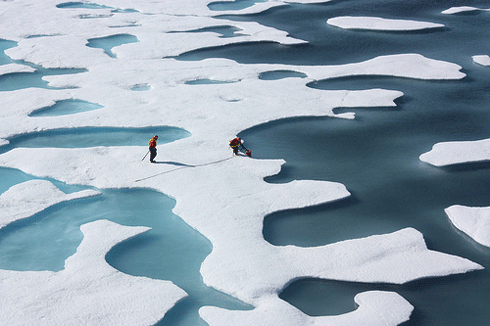
|
Published: 6 March 2012
Heavy snows linked to melting Arctic sea ice
Results of a new study add to evidence of a relationship between melting ice in the Arctic and widespread cold outbreaks in the Northern Hemisphere. The results could be used to improve seasonal forecasting of snow and temperature anomalies across northern continents.

|
|
Sea ice atop the Arctic Ocean during the annual spring and summer melt (taken 12 July 2011). As ice melts, freshwater collects in depressions on the surface and deepens them, forming melt ponds. These freshwater ponds merge with the surrounding sea when intervening ice barriers disappear. Credit:
NASA Goddard Photo and Video
|
The study, led by researchers at the Georgia Institute of Technology and published in Proceedings of the National Academy of Sciences shows that since the level of Arctic sea ice set a new record low in 2007, significantly above-normal winter snow cover has occurred across much of the Northern Hemisphere.
During the winters of 2009–2010 and 2010–2011, the Northern Hemisphere measured its second and third largest snow cover levels on record.
‘Our study demonstrates that the decrease in Arctic sea ice area is linked to changes in the winter Northern Hemisphere atmospheric circulation,’ says co-author, Judith Curry, Chair of the institute’s School of Earth and Atmospheric Sciences.
‘The circulation changes result in more frequent episodes of atmospheric blocking patterns, which lead to increased cold surges and snow over large parts of the northern continents.’
The researchers analysed observational data collected between 1979 and 2010 and found that a decrease in autumn Arctic sea ice of 1 million square kilometres – an area the size of Egypt – corresponded to significantly above-normal winter snow cover in large parts of the northern US, northwestern and central Europe, and northern and central China.
The analysis revealed two major factors that could be contributing to these unusually large snowfalls: changes in atmospheric circulation and changes in atmospheric water vapour content, both of which are linked to diminishing Arctic sea ice.
Strong warming in the Arctic through the late summer and autumn appears to be enhancing the melting of sea ice.
Co-author Jiping Liu says the retreating arctic ice alters atmospheric circulation patterns by ‘weakening westerly winds, increasing the amplitude of the jet stream and increasing the amount of moisture in the atmosphere’.
‘These pattern changes enhance blocking patterns that favour more frequent movement of cold air masses to middle and lower latitudes, leading to increased heavy snowfall in Europe and the Northeast and Midwest regions of the United States,’ he says.
As well as analysing observational data, the researchers compared results of model simulations run with different sea ice distributions.
The simulations showed diminishing Arctic sea ice induced a significant surface warming in the Arctic Ocean and Greenland/northeastern Canada, and cooling over northern North America, Europe, Siberia and eastern Asia.
The models also showed above-normal winter snowfall in large parts of the northern US, central Europe, and northern and central China.
The consistent relationships seen in the model simulations and observational data illustrate that the rapid loss of sea ice in summer and delayed recovery of sea ice in autumn influences snow cover, winter temperature and the frequency of cold air outbreaks in northern mid-latitudes.
Source: Georgia Institute of Technology



